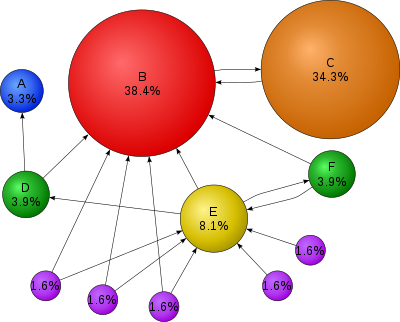PageRank
PageRank (PR) merupakan algoritma yang digunakan oleh Carian Google untuk pangkat laman web dalam keputusan enjin carian mereka. PageRank dinamakan sempena Larry Page,[1] salah seorang pengasas Google. PageRank ialah cara untuk mengukur kepentingan halaman laman sesawang. Menurut Google:

PageRank berfungsi dengan mengira bilangan dan kualiti pautan ke halaman untuk menentukan anggaran kasar betapa pentingnya laman web tersebut. Andaian mendasari adalah bahawa laman web yang lebih penting mungkin menerima lebih banyak pautan dari laman web lain.[2]
Kini, PageRank bukan satu-satunya algoritma yang digunakan oleh Google bagi mencari hasil keputusan, namun ia merupakan algoritma yang pertama telah digunakan oleh syarikat, dan ia lebih dikenali.[3][4]
Rujukan
suntingPetikan
sunting- ^ "Google Press Center: Fun Facts". www.google.com. Diarkibkan daripada yang asal pada 2001-07-15.
- ^ "Facts about Google and Competition". Diarkibkan daripada yang asal pada 4 November 2011. Dicapai pada 12 July 2014.
- ^ Sullivan, Danny. "What Is Google PageRank? A Guide For Searchers & Webmasters". Search Engine Land. Diarkibkan daripada yang asal pada 2016-07-03. Unknown parameter
|dead-url=ignored (bantuan) - ^ Cutts, Matt. "Algorithms Rank Relevant Results Higher". www.google.com. Diarkibkan daripada yang asal pada July 2, 2013. Dicapai pada 19 October 2015. Unknown parameter
|dead-url=ignored (bantuan)
Sumber
sunting- Altman, Alon; Moshe Tennenholtz (2005). "Ranking Systems: The PageRank Axioms" (PDF). Proceedings of the 6th ACM conference on Electronic commerce (EC-05). Vancouver, BC. http://www.eecs.harvard.edu/cs286r/courses/fall11/papers/AT%2705.pdf. Diperolehi 29 September 2014.
- Cheng, Alice; Eric J. Friedman (2006-06-11). "Manipulability of PageRank under Sybil Strategies" (PDF). Proceedings of the First Workshop on the Economics of Networked Systems (NetEcon06). Ann Arbor, Michigan. http://www.cs.duke.edu/nicl/netecon06/papers/ne06-sybil.pdf. Diperolehi 2008-01-22.
- Farahat, Ayman; LoFaro, Thomas; Miller, Joel C.; Rae, Gregory; Ward, Lesley A. (2006). "Authority Rankings from HITS, PageRank, and SALSA: Existence, Uniqueness, and Effect of Initialization". SIAM Journal on Scientific Computing. 27 (4): 1181–1201. doi:10.1137/S1064827502412875.
- Haveliwala, Taher; Jeh, Glen; Kamvar, Sepandar (2003). "An Analytical Comparison of Approaches to Personalizing PageRank" (PDF). Stanford University Technical Report. http://www-cs-students.stanford.edu/~taherh/papers/comparison.pdf.
- Langville, Amy N.; Meyer, Carl D. (2003). "Survey: Deeper Inside PageRank". Internet Mathematics. 1 (3).
- Langville, Amy N.; Meyer, Carl D. (2006). Google's PageRank and Beyond: The Science of Search Engine Rankings. Princeton University Press. ISBN 0-691-12202-4.
- Richardson, Matthew; Domingos, Pedro (2002). "The intelligent surfer: Probabilistic combination of link and content information in PageRank" (PDF). Proceedings of Advances in Neural Information Processing Systems. 14. http://www.cs.washington.edu/homes/pedrod/papers/nips01b.pdf.
Paten relevan
sunting- Original PageRank U.S. Patent—Method for node ranking in a linked database—Patent number 6,285,999—September 4, 2001
- PageRank U.S. Patent—Method for scoring documents in a linked database—Patent number 6,799,176—September 28, 2004
- PageRank U.S. Patent—Method for node ranking in a linked database—Patent number 7,058,628—June 6, 2006
- PageRank U.S. Patent—Scoring documents in a linked database—Patent number 7,269,587—September 11, 2007
Pautan luar
sunting- Algorithms by Google
- Our products and services by Google
- How Google Finds Your Needle in the Web's Haystack by the American Mathematical Society